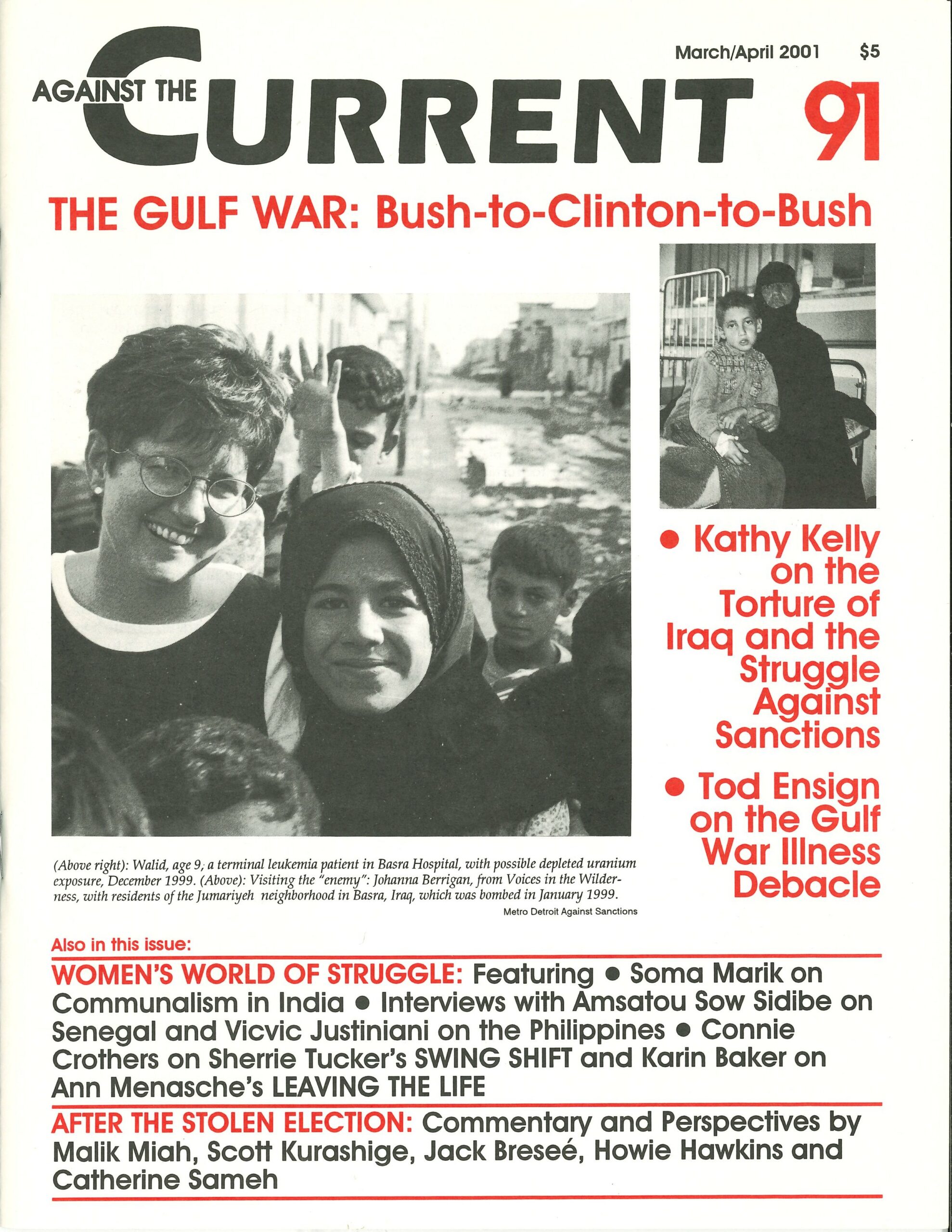Against the Current, No. 91, March/April 2001
-
Dirty Done Deals
— The Editors -
Energy: The Fleecing of California
— Barry Sheppard -
Fourthwrite for Irish Freedom
— Stuart Ross interviews Tommy McKearney - Republican Dissidents Targeted
-
Yugoslavia's Post-Milosevic Paradox
— Catherine Samary -
Canada: Activists Face the Future
— Toby Moorsom -
Random Shots: Daimler and Dubya Chronicles
— R.F. Kampfer - After the Stolen Election
-
Thieving Sons of Bushes
— Malik Miah -
Asian American Activism Stirring
— Scott Kurashige -
Ashcroft? The Road to Theocracy?
— Jack Breseé -
The Rebel Girl: Broaden the Challenge
— Catherine Sameh -
Nader, Greens and Socialists
— Howie Hawkins - Women's World of Struggle
-
Training for Freedom in Senegal
— Mark Brenner interviews Amsatou Sow Sidibe -
The Struggle to Stop Female Genital Mutilation
— Mark Brenner -
India's Communalist Violence Against Women
— Soma Marik -
Philippines Organizing and Repression
— Delia Aguilar interviews Vicvic Justiniani - The Gulf War Ten Years After
-
Iraq's Torture by Sanctions
— an interview with Kathy Kelly -
A Decade of Gulf War Illness
— Tod Ensign -
Depleted Uranium: Scandal Update
— Tod Ensign -
U.S. Bombing: Murder as Usual
— Voices in the Wilderness - Reviews
-
Sherrie Tucker's "Swing Shift"
— Connie Crothers -
Ann Menasche's "Leaving the Life"
— Karin Baker - In Memoriam
-
In Memoriam: Daniel Singer
— Michael Löwy
Tod Ensign
IN THE FIRST weeks of the new year, a new controversy has erupted among NATO allies over possible health effects of the Pentagon’s use of depleted uranium (DU) weapons on their troops who served in Bosnia, Kosova and Serbia.
The European Union and several individual states, Italy, Spain and Holland among them, have demanded an investigation into the use of DU weapons by American and NATO warplanes during air assaults on Serbia and Kosova in 1999 and Bosnia in 1995. The weapons are favored because their hardness and density make them highly effective against armored vehicles and tanks.
Veterans from several NATO countries who fought in the Balkans have developed cancer, including a number of leukemia cases. Six Italian, five Belgian, and two soldiers each from Holland and Spain are reported to have already died.
The Pentagon has admitted that its A-10 Warthog jets fired at least 31,000 DU rounds during their sorties during the Kosova conflict in 1999. The Pentagon’s scientists, however, have insisted that there’s no evidence that DU weapons have caused any harm to humans from contamination after detonation.
The Gulf War marked the first use of depleted uranium weapons by any military. Almost a million 30mm rounds were fired by A-10 jets, while another 14,000 larger rounds were fired by tanks. An estimated 300 tons of uranium waste from spent rounds even today lie scattered over the Iraqi and Kuwaiti battlefields.
Nearly all these exposures could have been avoided had the U.S. military implemented simple rules to prevent GIs from handling contaminated residue or entering contaminated areas.
The latest furor was sparked when a United Nations environmental assessment team detected pockets of measurable beta radiation in Bosnia, Kosova and Serbia. “We are recommending that contaminated areas should be clearly marked and fenced off,” team director Pekka Haavisto told the New York Times (1/7/01).
The UN team had been hampered in the conduct of its research by the Pentagon’s year-long delay in responding to its request for details about bombing targets during the Kosova war. The team found measurable levels of radioactive contamination at eight of the eleven bombsites they assayed, picked from 112 NATO designated target areas.
A chief question with depleted uranium is how much harm is caused when residue particles are inhaled. Some experts claim that enormous quantities would have to be inhaled to cause harm. But British biologist Dr. Roger Coghill recently told a conference of DU activists in England that “one single particle of DU lodged in a lymph node can devastate the entire immune system.” (New York Times, 1/7/01)
One longtime DU activist, Maj. Doug Rottke (Res.) held a press conference in London’s Parliament on January 30, 2001, where he condemned the continued use of DU weapons by NATO forces as a “war crime.” Rottke led the Army’s DU assessment team into Iraq and Kuwait after the Gulf War. (Reuters dispatch, 1/30/01)
According to Rottke, the Pentagon has consistently ignored his team’s warnings about the health hazards of DU weapons. “When we got to Saudi Arabia (in 1991) we were as healthy as horses. Now my guys are sick or dead,” he told the New York Post (1/7/01). Twenty of the 100-member team have died and many others are ill, including himself, says Rottke, who has had fifteen kidney operations since 1995 and also suffers from respiratory problems and rashes.
An Army pamphlet that he helped write in 1995, which advises about precautions for handling DU-contaminated equipment, has never been distributed to troops or civilians following the air war over Serbia and Kosova, according to Maj. Rottke.
The Pentagon for its part continues to insist that there’s no evidence of human health effects from DU exposure. Bernard Rostker, Pentagon Special Assistant for Gulf War Illness, emphasized that recent (military-financed) research “did not find a plausible link between DU and any health problems.” (Stars and Stripes, 1/29/01)
ATC 91, March-April 2001

